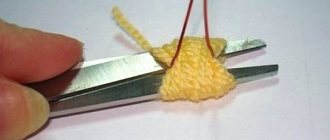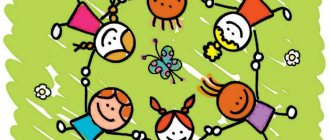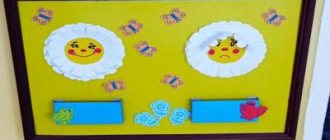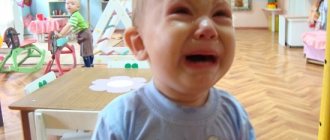The role of corners in children's development
Let's start with the fact that the design of corners in kindergarten is of great importance, especially for children. The child spends most of his time here. And everything fundamental in character, behavior and habits is laid down from a very early age. That is why preschool childhood is an important period in the life of every child. At this stage, he gains experience in social relations, gets to know society, learns to communicate with people, becomes familiar with acceptable forms of behavior and learns to follow them.
For proper and harmonious development, it is important for a child to communicate with peers. This is one of the main reasons why children are sent to kindergarten. Factors such as parents’ employment, the need for adaptation and training, and much more also play an important role.
Children spend a lot of time in kindergarten and their activities there are very diverse: from outdoor games to quiet activities with a teacher. That is why properly organized play areas in kindergarten are of great importance for the development of preschoolers.
The atmosphere in the kindergarten should be such that the child wants to come there. This is especially true for the younger group, because the children have just begun to get used to a new life and a new team, and for the first time they began to be separated from mom and dad for a long time. Everything should help ensure that the process of adaptation to kindergarten is painless. The design of the kindergarten is also of great importance.
The design of a group in kindergarten should not be bright and flashy. Let the light background prevail. Depicting an excessive number of cartoon and fairy-tale characters on the walls is not always justified, especially if these images are large in size. The kid should not be afraid of the huge turtle from the cartoon, which he still does not know at all. It needs to be something educational. For example, the theme of the seasons, because children in the younger group are still very young and are just beginning to learn what snow, rain, and leaves on trees are. The size of the images should not exceed the norm, because the age characteristics of children do not yet allow them to focus their gaze well enough to distinguish large objects.
The knowledge and skills acquired by a child in kindergarten are the basis for his successful education in primary school. Here, teachers unobtrusively, often in a playful way, help the child get acquainted with some school knowledge: numbers, letters, and attend nature and creativity lessons. Classes are held in the form of marathons, competitions, lessons, and holidays. It should also be noted that the child independently studies the information available to him. How can group corners designed by the teacher in kindergarten help?
When thinking about the design of a group in a kindergarten, it would be advisable to divide it into zones. The usual zoning of a group in a kindergarten is: bedroom, dining room, play area and activity area, but additional options can be provided.
There should, of course, be no distracting images where children sleep, as well as in the dining room. But we should talk about developmental zones in kindergarten in more detail.
Zoning in kindergarten
Perhaps, when planning play areas in a preschool educational institution according to the Federal State Educational Standard, one should, first of all, take into account the age of the children and their number. It is also worth finding out the opinion of parents: by asking what they want to see in the group, this will not only show your interest, attention and respect, but also, most likely, you will find proactive helpers.
For convenience, transfer all original ideas for designing a group in a kindergarten to a drawing plan, be sure to indicate on it the names of the corners and their locations.
Depending on the vastness of the space, zoning in a kindergarten group can be quite rich. Below are the most popular zones in the kindergarten group according to the Federal State Educational Standard. Select and organize those that will correspond to your current goals and objectives for the development and upbringing of children.
Zoning in the preparatory group of kindergarten
Outdoor games area
Physical education plays a vital role in the development of children, and it is also important to remember this when planning the design of a kindergarten. Of course, modern kindergartens have gyms and swimming pools, but it is still worthwhile to provide a mini-health corner in the group. This area should be spacious enough. Children should be able to run and jump. A gymnastic wall and various sports equipment would be appropriate here: hoops, balls, skittles, jump ropes. However, we must not forget that the equipment must be appropriate for the age of the children.
Role-playing games area
The design of play areas in a kindergarten provides wide scope for creativity for their organizer. There should, of course, be a lot of toys here. But among their number, children must be able to navigate. Therefore, it is necessary to make themed corners. Separately, you can organize a hairdresser with a chair, dolls and toy tools; hospital, where there will be white coats and medical supplies. You can also create a kitchen corner for girls in kindergarten. To organize it, a toy stove, dishes, food, an apron and a chef's hat, as well as dolls in aprons, are suitable.
Girls, with their favorite games of mother-daughter, tea party or shopping, will feel cozy in a special playhouse. Be sure to post it if possible.
There is also a place for boys in the playhouse; they will be the ones who will come to visit and learn the basics of etiquette. Their play area can be placed nearby and its design can be approached in an equally original way, for example, by making an impromptu garage, where there will be cars of different sizes and purposes: trucks, cars, dump trucks, buses, ambulances, police and fire departments. A railway could also be built here. You can also make a small repair shop corner with toy hammers, nuts, screws and other supplies.
Correctly designing areas in a kindergarten is an excellent opportunity for a teacher to unobtrusively show children the basics of adult life: what and how to cook with, how to properly receive guests, take care of younger children, and much more.
Study area in kindergarten
In the learning corner there must be a table at which several children can be seated at the same time. There they can draw, make crafts, learn to read, count and play relaxing board games.
The filling and design of the learning area in kindergarten should take into account the age of the children. Place here cubes, mosaics, various kinds of construction sets that do not contain small parts, educational and educational board games - here kids can practice, developing fine motor skills and expanding their knowledge about the world around them. Don't forget to allocate space for the simplest geometric shapes, shapes of different colors.
The safety corner can be placed separately or, if group space does not allow, it can be made part of the study area. Post here information about traffic rules, fire safety, and standards of behavior indoors and outdoors.
Social Development Zone
The previous zone can be separated by a bookcase or bookcases, combining with a social development corner and a book corner. It is advisable to locate this area away from the place of noisy games, because, being distracted, the child will not be able to concentrate on communicating with the book. The corner should be well lit and have a place where the baby can sit and leaf through a book.
Through a book, a child learns a whole range of human feelings, thoughts, and relationships between characters. By identifying himself with a hero, a child takes on a certain model of behavior, which he tries to follow throughout his life. It is necessary to provide a corner with various books appropriate to the age category of children. There should be fairy tales, instructive stories, books about nature, as well as educational books. The corner should be regularly replenished with new interesting and colorful specimens, thereby maintaining children’s interest in it.
In the social development zone there is a place not only for books, but also for a small family history of each child. Try inviting parents and children to choose photos for small family albums that they can proudly show to friends when talking about family, important events or travel.
Corner of nature
There is no doubt that designing a corner of nature in a kindergarten is an excellent basis for introducing a child to natural phenomena.
In the younger group, as a rule, the corner of nature is limited to indoor plants, but for children in the older group it will be much more interesting to study the calendar, the change of seasons, natural phenomena, parts of plants and trees.
The theme of the corner of nature deserves special attention. It is much more interesting when the exhibition changes, for example, once a quarter, then such a corner of the group will attract much more attention from the child. As winter approaches, it is useful to fill it with information on caring for birds at this time, for example, display photographs of wintering birds, perhaps build a feeder with children in labor lessons.
Creating a greenhouse is also of no small importance. Using the example of different types of plants, the child will understand that plants are different, that not all have a stem, but they all have roots, and the leaves can be of different shapes. You can add butterflies or dragonflies to your greenhouse, which children can make on their own. And if the pots with plants are labeled, it will be doubly educational. In the summer, a corner of nature can be supplemented with living garden or field plants or flowers, and in the fall with the fruits that nature gave.
The living inhabitants of the natural corner in the kindergarten will deserve special interest among the children. There could be a cage with a hamster or an aquarium with fish, and kids can be taught the basics of caring for animals. Before getting a pet, you must obtain the consent of all parents, be sure to ask adults if their children have allergies, and do not forget about a certificate from a veterinarian.
Preschool institutions, as a rule, do not effectively use the area in front of the kindergarten. Quite rarely, children are involved in landscaping the site, where corners such as vegetable gardens, flower beds, and corners of the garden have been created, which can be used to develop the basics of environmental consciousness in the child.
Music Development Zone
A music corner in kindergarten will help to reveal creative talents and increase the overall level of education. If it is not possible to place children's musical instruments there, limit yourself to pictures and a player.
Patriotic education zone
And in cultivating a love of work and patriotism, a local history corner will be a faithful assistant, in which there will be a place for objects of applied art and folk crafts that are popular in your area. Also, be sure to place symbols and portraits of the heads of state and your region here. This area will be especially decorated with dolls in national costumes, even if they are cut out of paper.
Creative Development Zone
The real decoration and pride of the kindergarten group is the children's creativity corner. The children’s works are not only aesthetic in nature, but also stimulate the child to achieve further success and serve as a clear example of the interaction between the teacher and the child.
Creative corners in the group, as a rule, are limited to an exhibition of children's works and crafts. But this is not the only function they can perform. For example, you can organize educational corners in preschool educational institutions dedicated to the work of various people, for example, famous artists or composers.
It is not necessary to use a small space for a creativity corner. For example, when preparing for the New Year, you can cut out and decorate the entire group with snowflakes: thus, you will get a “children’s creativity room.” And if you decorate the Christmas tree with homemade toys, you will get a “Christmas tree of children’s creativity.”
Children love to do things with their own hands; they always try and are happy with the result, if it also turns out to be satisfactory. And if there is an opportunity to decorate and display works in a different way, then you should not limit yourself to just a corner of creativity.
When forming zones in a preschool educational institution according to the Federal State Educational Standard, remember that the main requirement for the environment and design of a group in a kindergarten is safety. Avoid sharp corners, slippery floors, and ensure that wall shelves or decorative items are securely attached.
Approach space planning and design of activity areas in kindergarten creatively and with love, and you will definitely have a cozy group where both children and their parents will be happy to come every day!
The importance of the developing subject-spatial environment of preschool educational institutions. article on the topic
The importance of the developing subject-spatial environment of a preschool educational institution.
Preschool childhood is a short but important, unique period of a person’s life. Humanity has only gradually come to realize the intrinsic value of childhood, as a part of human life, and not just its threshold. During these years, the child acquires initial knowledge about the life around him, he begins to form a certain attitude towards people, towards work, develops skills and habits of correct behavior, and develops a character. The child has his own specific human rights, proclaimed in the Declaration of the Rights of the Child adopted by the United Nations. Among other vital and social rights, there is also the child’s right to play - the most important condition for his mental, social, and physical development.
A huge role in the development and upbringing of a child belongs to play - the most important type of activity, during which the spiritual and physical strength of the child develops. A game is a type of unproductive activity, the motive of which lies not in its results, but in the process itself.
It is an effective means of shaping the personality of a preschooler, his moral and volitional qualities; the game realizes the need to influence the world. It causes a significant change in his psyche. The most famous teacher in our country A.S. Makarenko characterized the role of children’s games in the following way: “Play is of great importance in a child’s life, it has the same meaning as an adult’s activity, work, service. What a child is like at play, so in many ways he will be at work. Therefore, the upbringing of a future leader occurs, first of all, in the game...”
For children, play, which is commonly called a “childhood companion,” constitutes the main content of life, acts as a leading activity, and is closely intertwined with work and learning. All aspects of the personality are involved in the game: the child moves, speaks, perceives, thinks; During the game, all his mental processes are actively working: thinking, imagination, memory, emotional and volitional manifestations are intensified. The game acts as an important means of education.
Through play, a child enters the world of adults, masters spiritual values, and assimilates previous social experience. We can consider that in the game the child receives for the first time a lesson in collective thinking. This circumstance is of fundamental importance if we take into account that the child’s future is connected with socially useful work, the most important quality of which is the joint, collective solution of problems aimed at achieving a common goal. One of the most important factors in the development of a child’s personality is the environment in which he lives, plays, studies and relaxes.
The social world in which a child lives and develops is filled with content that preschool children show interest in learning and which they can fully assimilate and understand. This is knowledge of oneself as a representative of the human race, people, the nature of relationships with them, the content of their activities, way of life, knowledge of the objective and natural world. The social world is multifaceted and diverse, it is contradictory and ambiguous - all this provides the basis for the development of the child’s activity in the process of his cognition and understanding.
The cognitive activity of preschool children should be understood as the activity that arises regarding cognition and in its process. It is expressed in the interested acceptance of information, in the desire to clarify and deepen one’s knowledge, in the independent search for answers to questions of interest, in the use of comparison by analogy and in contrast, in the ability and desire to ask questions, in the manifestation of elements of creativity, in the ability to assimilate the method of cognition and apply it to another material.
By getting to know himself, his abilities, skills, the child learns to analyze and draw conclusions about his capabilities; material on the objective world makes the child think about many things: about the origin of objects, about the power of the human mind, about the properties, purpose, qualities of objects, etc. In a preschool educational institution, this world is represented by a developing subject-spatial environment, which ensures the psychological security of each child, with the help of which the knowledge, abilities, skills necessary for the full development of the individual are formed, and the individuality of children develops.
The concept of a developing subject-spatial environment is considered in pedagogy as a narrower characteristic of the environment, as a factor that stimulates, guides, and develops the child’s activity. It influences the development of the individual in a broad sense and the formation of narrower qualities, such as independence, activity, and observation. A developing subject-spatial environment is a system of material objects of a child’s activity that functionally models the content of his spiritual and physical development.
.
The enrichment of the developing subject-spatial environment is directly dependent on the content of education, age and level of development of children and their activities. The developmental environment in groups is appropriate, informed, creates an image of a particular process, adjusts to an emotional mood, ensures a harmonious relationship between the child and the world around him, provides the child with freedom, and influences the child’s attitude, well-being, and health.
All components of the subject-development environment are interconnected in content, scale, and artistic design. The subject-spatial world of a kindergarten includes a variety of objects and objects of social reality. Such an environment is necessary for children, first of all, because it performs an informative function in relation to them - each object carries certain information about the world around them and becomes a means of transmitting social experience.
The subject-based play environment in a preschool institution meets certain requirements: first of all, this is the freedom of the child to achieve the theme, the plot of the game, certain toys, the place and time of the game. At the same time, one cannot fail to take into account the age characteristics of preschool children and the fact that they are in a preschool educational institution working according to a specific educational program. This means that when creating conditions in a preschool institution for children to exercise their right to play, it is necessary to offer them not only the most convenient time in their daily routine for play, but also to allocate a suitable place, equipping it with a universal object-based play environment suitable for organizing various types of play. games.
All play centers should be located so that children have the opportunity to freely engage in different activities without disturbing each other. When organizing a subject-spatial environment in preschool groups, complex, multifaceted and highly creative activities are required. After all, a variety of toys is not the main condition for a child’s development. A purposefully organized subject-developmental environment in a preschool educational institution plays a big role in the harmonious development and upbringing of a child. The created environment evokes in children a feeling of joy, an emotionally positive attitude towards kindergarten, a desire to attend it, enriches them with new impressions and knowledge, encourages active creative activity, and promotes the intellectual and social development of preschool children.
Therefore, the environment in a preschool educational institution is not only a condition for the creative self-development of a child’s personality, a factor of health improvement, but also an indicator of the professionalism of teachers, a wonderful creative team of like-minded people.








